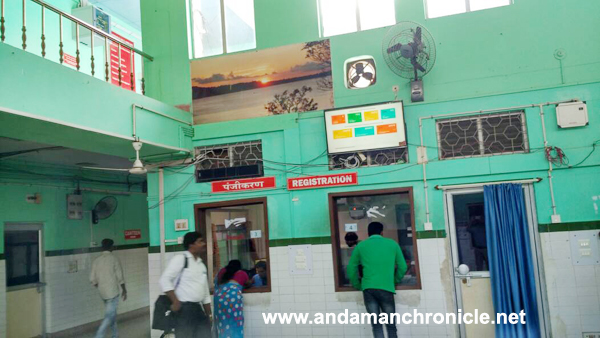
Report: Rashmi and Karthika
Port Blair, April: The Indian Medical and Health sector has long been plagued by enormous, derelict piles of hastily scribbled medical records, abandoned files and incoherent patients who do not know their own blood group or history. While world over, hospitals have switched over to an electronic patient management system, the Indian hospitals have only recently followed suit.
Paving the way for efficient and swift management of medical records, the G.B Pant Hospital began the process of implementing an automated system of entry for their patients. On 22nd February 2017, in a gradual phase wise schedule the hospital adopted “e-Hospital” by NIC Tripura, a patient centric and generic application software, specifically designed for hospitals in Government Sectors with the main objectives being to provide a mechanism to access the patient records and history- a complete end to end solution for OPD/IPD patients in areas of clinical, administration and billing.
The method of locating a patient's medical history is either via Aadhaar or mobile number. During the time of registration, a patient is asked for their Aadhaar number and other personal information which is then fed into the system with the allotted registration number and unique barcode. As of now, the Aadhaar number is not a mandatory requirement, and patients can also provide their mobile number to locate their medical files. Registration through the Aadhaar number is promoted by the hospital as the Islands have an approximate 96% coverage. The choice of Aadhaar as the source of identification was a logical one, as the Islander ID penetration is less than 50% and mobile numbers are shared by multiple members of each family.
The hospital has provided different counters for new patients and revisiting patients. With the initial registration already in place, revisiting patients will only have to provide their Aadhaar number and the hospital administration can instantly locate their medical history. This medical record will significantly improve the patient's treatment as their doctors can take into consideration their previous medical conditions during treatment, which is an essential necessity. Follow up checkups and chronic health issues can be detected without the patients having to bring along with them paperwork from their previous treatments. When fully operational, the system will have LCD monitors that can provide direct information to the visitors, a kiosk for self registration and access to their medical records.
The immediate increase in administrative efficiency is remarkable, barcode implementation in patient card, order slip and specimen tube has reduced errors and search time. Integration of analysers has increased the accuracy of laboratory observation data. The amount of time in dispensation of medicines in the pharmacy has also sharply reduced.
Direct data is now available that testifies to this. Although there was an initial rabid rush in registration of patients on the new system as can be expected, over the last two months of implementation the system has already stabilised. There is a steady increase in the number of patient revisits and decrease in new registrations. The time spent previously on registering each patient who visits- as was the case before- is now saved, due to medical history being directly available due to entered records. The counters now have small queues, as the time spent per patient has reduced. Currently, around five hundred new patients register on the system each day, while nearly nine hundred revisits are clocked, peaking at 1300 revisits per day in the previous week. This number will clearly increase with time and it is projected that by the end of the year, new registrations will hit single digits.
A major breakthrough for the new system is that it allows the hospital to keep watch over the dispensation of medication. Previously a patient with a registration and doctor's slip was able to procure any medication, the system now accounts for the validity of the person's need for the specific medicine. If patients have received medicine for a period of time, then till that period ends the patient is not eligible for the medication. This significantly curbs the illegal black market sale of medicines taken from the government hospital. It also stops the hoarding of medicine, which was noticed before.
The few loopholes that exist in the system are now being sealed shut. Duplication of Aadhaar numbers is no longer possible with the implementation of software that automatically detects a previously entered UHID under an alias, and either blocks the new one or merges with another, in case of multiple registrations. These loopholes exist solely because Aadhaar is not mandatory and various patients still use mobile numbers for registration. To date, about twenty thousand patients have registered with Aadhaar and cooperation has been high as both staff and patients become familiar with the electronic system.
With the successful implementation of the first phase, in registration, billing, orthopaedic department and gynecology, the system is being extended into other areas of the hospital. The laboratory and pharmacy are the next on the line, with stocking, results, procurement, quantities, etc. all being recorded by the e-hospital software.
The system has been slowly integrated into the hospital and staff are being trained to fully implement it. Initially the new system faced pressure in its decision to use Aadhaar as the preferred method of patient ID, but Dr. Ritesh Mondal who is in charge of the implementation of e-Hospital and his team, with the support of the Director of ANIIMS, Dr. R.P Choubey- have traversed the initial spheres of challenges and are optimistic about the full implementation of the system in all sectors of the hospital. Though the software is not without bugs and difficulties, the passion of the doctors for efficiency as well as the adaptability of the patients has allowed the progressive and much needed initiative of the Government to become a clear success.